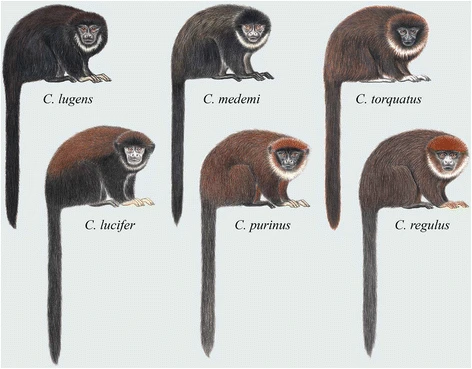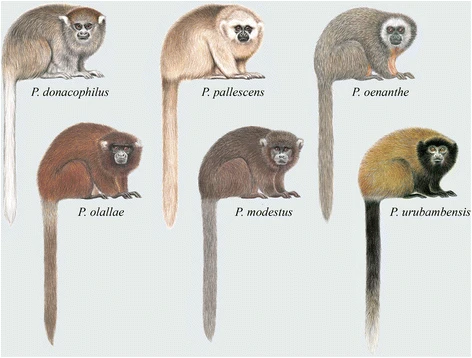|
List Of New World Monkey Species
New World monkeys are all simian primates. While they are endemic to South and Central America, their ancestors rafted over or traversed via land bridge from Africa across the Atlantic Ocean when it was much narrower than at present. Taxonomic classification * Infraorder Simiiformes ** Parvorder Platyrrhini - New World monkeys *** Family Callitrichidae: marmosets and tamarins **** Genus ''Saguinus'': true tamarins **** Genus ''Leontocebus'': saddle-back tamarins **** Genus ''Leontopithecus'': lion tamarins **** Genus ''Callimico'' **** Genus ''Mico'' **** Genus ''Cebuella'' **** Genus ''Callithrix'' *** Family Cebidae: capuchins and squirrel monkeys **** Subfamily Cebinae ***** Genus ''Cebus'': gracile capuchins ***** Genus ''Sapajus'': robust capuchins **** Subfamily Saimiriinae ***** Genus ''Saimiri'': squirrel monkeys *** Family Aotidae: night or owl monkeys, also called douroucoulis **** Genus '' Aotus'' *** Family Pitheciidae: titis, sakis and uakaris **** Subfamily Cal ... [...More Info...] [...Related Items...] OR: [Wikipedia] [Google] [Baidu] |
New World Monkeys
New World monkeys are the five families of primates that are found in the tropical regions of Mexico, Central and South America: Callitrichidae, Cebidae, Aotidae, Pitheciidae, and Atelidae. The five families are ranked together as the Ceboidea (), the only extant superfamily in the parvorder Platyrrhini (). Platyrrhini is derived from the Greek for "broad nosed", and their noses are flatter than those of other simians, with sideways-facing nostrils. Monkeys in the family Atelidae, such as the spider monkey, are the only primates to have prehensile tails. New World monkeys' closest relatives are the other simians, the Catarrhini ("down-nosed"), comprising Old World monkeys and apes. New World monkeys descend from African simians that colonized South America, a line that split off about 40 million years ago. Evolutionary history About 40 million years ago, the Simiiformes infraorder split into the parvorders Platyrrhini (New World monkeys) and Catarrhini (apes and Old World mon ... [...More Info...] [...Related Items...] OR: [Wikipedia] [Google] [Baidu] |
Cebuella
Pygmy marmosets are two species of small New World monkeys in the genus ''Cebuella''. They are native to rainforests of the western Amazon Basin in South America. These primates are notable for being the smallest monkeys in the world, at just over . They are generally found in evergreen and river-edge forests and are gum-feeding specialists, or gummivores. About 83% of the pygmy marmoset population lives in stable troops of two to nine individuals, including a dominant male, a breeding female, and up to four successive litters of offspring. The modal size of a standard stable troop would be six individuals. Although most groups consist of family members, some may also include one or two additional adult members. Members of the group communicate using a complex system including vocal, chemical, and visual signals. Three main calling signals depend on the distance the call needs to travel. These monkeys may also make visual displays when threatened or to show dominance. Chemical ... [...More Info...] [...Related Items...] OR: [Wikipedia] [Google] [Baidu] |
Cheracebus
''Cheracebus'' is one of three genera of titi monkeys. Monkeys in this genus, particularly the type species ''Cheracebus lugens'', are sometimes referred to as widow titi monkeys. Historically, titis were monogeneric, comprising only the genus ''Callicebus'' Thomas, 1903. Owing to the great diversity found across titi monkey species, a new genus-level taxonomy was recently proposed that recognises three genera within the subfamily Callicebinae; ''Cheracebus'' Byrne et al., 2016 for the species of the ''torquatus'' group (Widow titis); ''Plecturocebus'' Byrne et al., 2016 for the Amazonian and Chaco titis of the ''moloch'' and ''donacophilus'' groups; and ''Callicebus'' Thomas, 1903 ''sensu stricto'', for species of the Atlantic Forest ''personatus'' group. ''Cheracebus'' is derived from the Latin ''chera'' (from the Greek χηρα) meaning widow and ''cebus'' (from the Greek kebos) meaning long tailed monkey. Species There are 5 species in this genus: * Lucifer titi monkey, ''Ch ... [...More Info...] [...Related Items...] OR: [Wikipedia] [Google] [Baidu] |
Callicebus
''Callicebus'' is a genus of monkeys known as titi monkeys. Historically, titis were monogeneric, comprising only the genus ''Callicebus'' Thomas, 1903. Owing to the great diversity found across titi monkey species, a new genus-level taxonomy was recently proposed that recognises three genera within the subfamily Callicebinae; ''Cheracebus'' Byrne et al., 2016 for the species of the ''torquatus'' group (Widow titis); ''Plecturocebus'' Byrne et al., 2016 for the Amazonian and Chaco titis of the ''moloch'' and ''donacophilus'' groups; and ''Callicebus'' Thomas, 1903 ''sensu stricto'', for species of the Atlantic Forest ''personatus'' group. In 2014, a previously unknown orange ''Callicebus'' was spotted in the Peruvian Amazon; it has not been determined whether this constitutes a color variant or a new species. Species There are 5 species in this genus: * Barbara Brown's titi monkey, ''Callicebus barbarabrownae'' * Coimbra Filho's titi monkey, ''Callicebus coimbrai'' * Coastal bla ... [...More Info...] [...Related Items...] OR: [Wikipedia] [Google] [Baidu] |
Plecturocebus
''Plecturocebus'' is one of three genera of titi monkeys. Historically, these monkeys were monogeneric, being placed in a single genus: ''Callicebus'' Thomas, 1903. Owing to the great diversity found across titi monkey species, a new genus-level taxonomy was proposed in 2016 that recognises three genera within the subfamily Callicebinae; ''Plecturocebus'' Byrne et al., 2016 for the Amazonian and Chaco titis of the ''moloch'' and ''donacophilus'' groups; ''Cheracebus ''Cheracebus'' is one of three genera of titi monkeys. Monkeys in this genus, particularly the type species '' Cheracebus lugens'', are sometimes referred to as widow titi monkeys. Historically, titis were monogeneric, comprising only the genus ...'' Byrne et al., 2016 for the species of the ''torquatus'' group (Widow titis); and ''Callicebus'' Thomas, 1903 ''sensu stricto'', for species of the Atlantic Forest ''personatus'' group. ''Plecturocebus'' is derived from the Latin forms of three Greek words: plektos, m ... [...More Info...] [...Related Items...] OR: [Wikipedia] [Google] [Baidu] |
Callicebinae
The titis, or titi monkeys, are New World monkeys of the subfamily Callicebinae, which contains three extant genera: ''Cheracebus'', ''Callicebus'', and ''Plecturocebus.'' This subfamily also contains the extinct genera '' Miocallicebus, Homunculus'', and ''Carlocebus''. Titi monkeys live in South America, from Colombia, Ecuador and Peru, east through Brazil, and south to Bolivia and northern Paraguay. Description Depending on species, titis have a head and body length of , and a tail, which is longer than the head and body, of . The different titi species vary substantially in coloring, but resemble each other in most other physical ways. They have long, soft fur, and it is usually reddish, brownish, grayish or blackish, and in most species the underside is lighter or more reddish than the upperside. Some species have contrasting blackish or whitish foreheads, while all members of the genus ''Cheracebus'' have a white half-collar. The tail is always furry and is not prehensil ... [...More Info...] [...Related Items...] OR: [Wikipedia] [Google] [Baidu] |
Pitheciidae
The Pitheciidae () are one of the five families of New World monkeys now recognised. Formerly, they were included in the family Atelidae. The family includes the titis, saki monkeys and uakaris. Most species are native to the Amazon region of Brazil, with some being found from Colombia in the north to Bolivia in the south. Characteristics Pithecids are small to medium-sized monkeys, ranging from 23 cm in head-body length for the smaller titis, to 44–49 cm for the uakaris. They have medium to long fur, in a wide range of colors, often with contrasting patches, especially on the face. They are diurnal and arboreal animals, found in tropical forests from low-lying swamp to mountain slopes. They are predominantly herbivorous, eating mostly fruit and seeds, although some species will also eat a small number of insects. Sakis and uakaris have a diastema between the canine and premolar teeth, but the titis, which have unusually small canines for New World monkeys, do ... [...More Info...] [...Related Items...] OR: [Wikipedia] [Google] [Baidu] |
Night Monkey
Night monkeys, also known as owl monkeys or douroucoulis (), are nocturnal New World monkeys of the genus ''Aotus'', the only member of the family Aotidae (). The genus comprises eleven species which are found across Panama and much of South America in primary and secondary forests, tropical rainforests and cloud forests up to . Night monkeys have large eyes which improve their vision at night, while their ears are mostly hidden, giving them their name ''Aotus'', meaning "earless". Night monkeys are the only truly nocturnal monkeys with the exception of some cathemeral populations of Azara's night monkey, who have irregular bursts of activity during day and night. They have a varied repertoire of vocalisations and live in small family groups of a mated pair and their immature offspring. Night monkeys have monochromatic vision which improves their ability to detect visual cues at night. Night monkeys are threatened by habitat loss, the pet trade, hunting for bushmeat, and by bio ... [...More Info...] [...Related Items...] OR: [Wikipedia] [Google] [Baidu] |
Saimiri
Squirrel monkeys are New World monkeys of the genus ''Saimiri''. ''Saimiri'' is the only genus in the subfamily Saimirinae. The name of the genus is of Tupi origin (''sai-mirím'' or ''çai-mbirín'', with ''sai'' meaning 'monkey' and ''mirím'' meaning 'small') and was also used as an English name by early researchers. Squirrel monkeys live in the tropical forests of Central and South America in the canopy layer. Most species have parapatric or allopatric ranges in the Amazon, while ''S. oerstedii'' is found disjunctly in Costa Rica and Panama. There are two main groups of squirrel monkeys recognized. They are differentiated based on the shape of the white coloration above the eyes. In total there are 5 recognized species. Squirrel monkeys have short and close fur colored black at the shoulders, yellow or orange fur along the back and extremities, and white on the face. Squirrel monkeys have determined breeding seasons which involve large fluctuations in hormones and there is ... [...More Info...] [...Related Items...] OR: [Wikipedia] [Google] [Baidu] |
Sapajus
Robust capuchin monkeys are capuchin monkeys in the genus ''Sapajus''. Formerly, all capuchin monkeys were placed in the genus ''Cebus''. ''Sapajus'' was erected in 2012 by Jessica Lynch Alfaro et al. to differentiate the robust (tufted) capuchin monkeys (formerly the ''C. apella'' group) from the gracile capuchin monkeys (formerly the ''C. capucinus'' group), which remain in ''Cebus''. Taxonomy Based on the species and subspecies proposed by Groves in 2001 and 2005, robust capuchin monkey taxa include: * Black-capped, brown or tufted capuchin, ''Sapajus apella'' ** Guiana brown capuchin, ''Sapajus apella apella'' ** Colombian brown capuchin, ''Sapajus apella fatuellus'' ** Margarita Island capuchin, ''Sapajus apella margaritae'' ** Large-headed capuchin, ''Sapajus apella macrocephalus'' ** ''Sapajus apella peruanus'' ** ''Sapajus apella tocantinus'' * Blond capuchin, ''Sapajus flavius'' * Black-striped capuchin, ''Sapajus libidinosus'' ** ''Sapajus libidinosus libidinosus'' ... [...More Info...] [...Related Items...] OR: [Wikipedia] [Google] [Baidu] |
Cebus
Gracile capuchin monkeys are capuchin monkeys in the genus ''Cebus''. At one time all capuchin monkeys were included within the genus ''Cebus''. In 2011, Jessica Lynch Alfaro ''et al.'' proposed splitting the genus between the robust capuchin monkeys, such as the tufted capuchin, and the gracile capuchins. The gracile capuchins retain the genus name ''Cebus'', while the robust species have been transferred to ''Sapajus''. Taxonomy Following Groves (2005), taxa within the genus ''Cebus'' include: * White-fronted capuchin, ''Cebus albifrons'' ** Ecuadorian capuchin, ''Cebus albifrons aequatorialis'' ** Humboldt's white-fronted capuchin, ''Cebus albifrons albifrons'' ** Shock-headed capuchin, ''Cebus albifrons cuscinus'' ** Trinidad white-fronted capuchin, ''Cebus albifrons trinitatis'' ** Spix's white-fronted capuchin, ''Cebus albifrons unicolor'' ** Varied capuchin, ''Cebus albifrons versicolor'' * White-headed capuchin or white-faced capuchin, ''Cebus capucinus'' * Kaapor ... [...More Info...] [...Related Items...] OR: [Wikipedia] [Google] [Baidu] |






_portrait.jpg)